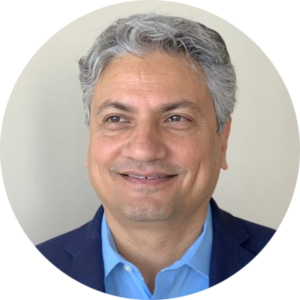Education’s core mission is to prepare the next generation for the challenges ahead — and those challenges look more daunting than ever as misinformation becomes its own plague and obstacles to the knowledge and critical thinking skills needed to thrive in the modern world persist, says Rajeev Arora, Capture Higher Ed’s new chief product officer.
“Education is probably more important to the survival of humanity than ever before,” he says, “and technology allows us to supercharge education, to scale up the efforts of schools, of institutions, of students and teachers, to achieve its mission.”
Arora, who oversees product strategy, innovation and scaling at Capture, brings more than 30 years of experience growing global software companies from concept to industry-leading businesses. Most of his career has been in the ed tech sector, with leadership roles at industry leaders such as Parchment, a provider of academic credential solutions for schools and universities; Blackboard, a leading provider of education-related software and services; and Elluminate, a virtual classroom software provider.
He came to Capture after serving as chief operating officer for Lingk, a higher education data integration platform, and chief marketing officer for Nearpod, which provides K-12 teachers an interactive classroom tool to engage students with online activities.
“I am so excited to be part of Capture,” says Arora, who earned his bachelor’s degree in electrical engineering from Rensselaer Polytechnic Institute in Troy, N.Y., and his master’s in engineering management from Santa Clara University in California. “I believe wholeheartedly in the mission of helping our partner institutions survive and thrive by providing the marketing services and a software intelligence layer that drives their enrollment and retention successes.”
Arora recently sat down — via Zoom, of course — from his home in Florida to talk about the challenges and virtues of working in the Ed Tech sector. He also discussed his product development processes as well as the viability and importance of a college education in a rapidly changing world. Some of the answers have been edited for brevity and clarity.
What do you like the most about working in the Ed Tech industry … where tech meets higher education?
It’s just been a great ride. I love the fact that education’s core mission is to make a difference in the world. I have two grown daughters of my own, and they used some of the products I helped build. It was a joy watching them use products my team created. Education has been a passion in my family for generations. My grandfather was a one-classroom teacher in a village. He was the only guy who could read and write. He was also the postman, so he could read and write the letters for people. Ever since then, the mantra for our family has been, “The only way to succeed is through education.”
My uncle came here for his higher education. I came to this country for my higher education. My girlfriend is a teacher. One of my daughters is a teacher. Education is very much a core passion. And technology helps us do that supercharging. The obstacles to education have probably never been higher than they are right now. We’ve got to fix these problems, and it’s great to be in a space where you feel like you’re making a difference.
In your view, what is the role of chief product officer at a company like Capture?
I’ve been at the junction of strategy and products at most of the companies I’ve worked for. Often with technology, the problem you are trying to solve is the biggest thing. Job number one for any chief product officer is to be a student of the problem. What are you trying to solve? What are the solutions that exist today? You must learn everything.
In Capture’s case, the problem is, how do we identify the students that our institutions are best at serving, and then ensure these students get the support to receive the education they need. What are all the nuances of that problem, and what are the different solutions that exist out there? And then once you have that knowledge, you must develop the vision to see what it is we can do uniquely. What is our distinct point of view on this world, on this problem? And we can say, “You know what? We think we should be doing things this way.”
In our case, we’re one of the few players who say, “We need high-quality technology, but then we need to support it with a high-quality services team.” So, this managed services model that we’ve got is unique. There’s not a lot of companies who do that. There are companies who are like, “We’re consultants. We’ll use any kind of technology out there.” And there are others who are like, “We’re technologists. You guys figure out how to use it.” We’re one of the few companies saying, “We know the technology. We developed it. And we’ll actually use that technology with you to help you achieve your goals.” It’s very distinct, very unique. That vision is the second job.
“Education is probably more important to the survival of humanity than ever before, and technology allows us to supercharge education, to scale up the efforts of schools, of institutions, of students and teachers, to achieve its mission.”
– Rajeev Arora, Capture CPO
After studying the problem and developing your vision, the third job is to build and lead a team of technologists. They must be passionate. They must be into the problem you’re trying to solve. We want a collection of people — project managers, developers, data scientists, cloud engineers — racing after perfection while delivering on that promise day in and day out.
If we’re saying at Capture, “Make every interaction count.” We need to figure out where all those interactions are and get the knowledge about those interactions to feed that back into the cycle to make the cycle work better. Those are the three key roles: be the student, develop the vision and lead that team of passionate individuals.
How do you identify, prioritize and build out new product ideas?
It’s back to being a student of the problem, right? The first thing you do is talk to the people trying to solve this problem. In Capture’s case, it’s the VPs of enrollment, or the VPs of marketing, the admissions officials … and then, because we’re a managed service, we have a whole internal team that’s using our technology to solve problems on behalf of our partner institutions. The first part, gather. Go talk to people. They have a million ideas!
And then, how do you now prioritize. For me there are about two or three different axis you must consider. One is the question, “What impact is this idea going to have?” You can service the impact in a few different ways. But an easy way, in our case, is to examine how much effort will the product save for people who might be doing things manually today. If I’m spending an hour a day, and there are a hundred institutions, and there are a hundred people at those institutions, that’s 10,000 hours a day I can save somebody. Efficiency is an easy way to go ahead and prioritize.
Return on investment is another one. You consider, “If we develop this, what are the big problems we can help solve?” One thing we’re working on, for example, is digital advertising. Lots of people are spending lots of money on digital advertising. Is it actually doing anything for them? Nobody really knows. We can bring our expertise in data science, and our expertise in enrollment marketing, and say, “OK, before you go spend,” whatever it is people are spending on digital, “what is the right way to do things? And what is the right way to go ahead and measure the impact of those things.” So, now suddenly, here’s a big, important problem and, if we’re able to go ahead and solve that, the entire industry gets much better. So, that’s the prioritization. What is the impact you can have from an efficiency standpoint and, if we did the right thing, what is the return on investment that can come out of the effort?
The third axis is more internal. What is the scale of effort we need to put in to solve this problem? When you can combine these three things — this is going to get to a lot of efficiency gain; this is going to get to a lot of return on investment; and this is not going to take much effort — those are low hanging fruit. Let’s grab those right away. But there are always going to be ideas that will take months or years to solve. And that’s OK. You just chunk them out and deliver value on an ongoing basis.
What are some of the unique challenges for companies trying to grow in the Ed Tech sector?
When I started out, Ed Tech was a very small sector. It’s bigger now, which is good. But it’s still very, very nuanced. Every institution is a snowflake with their own unique problems. If you’re trying to solve an enrollment problem, you may be asked, “Have you tried to solve this enrollment problem for my kind of institution?” They could be a big public university, or a small private university, or a community college. And then you may be asked, “Have you solved this problem for our kind of college in our kind of geography?” Or, “Have you solved this problem for our kind of college in our kind of geography that is trying to recruit students from India?” It’s forever unique.
And I completely understand. Most institutions have a heritage. They want to protect that heritage and build their brand based on that heritage. But they’re also trying to modernize. They’re entering a brave new world where a lot of things are changing. Education has not undergone as much of the impact of digitization as other industries. There used to be bookstores on every corner. Guess what? They’re not there anymore. And where they are, they have a very different business model. Newspapers are changing. Movies are changing. TV is changing. Everything. And education hasn’t changed as much.
“Job number one for any chief product officer is to be a student of the problem. What are you trying to solve? What are the solutions that exist today? You must learn everything.”
– Rajeev Arora
Over the next little while, education is going to need to change. I mean, over the last two years, education has been forced to change significantly. Suddenly we looked up, no campus. What do we do? All the technologies that institutions have embraced during the pandemic existed before. I remember, 40 years ago, we built a company called Elluminate that did a virtual classroom. It was a predecessor to the Zoom technology we have now. The scale really didn’t grow nearly as much then. But in the last two years, suddenly the world completely changed … and I don’t think that rate of change is going to slow down. There’s going to be something else new that’s going to happen, and education will need to adapt.
But education also can be hesitant, and for good reason. We’re dealing with humans. Not everything can happen online. A lot of growth happens when communities come together, when students are learning from each other, and from their professors, and they’re all in the same place.
So, it’s a unique industry. The only other industry I can equate it to is the healthcare industry. The rest of them are mostly about what’s going to make more money. That’s the end result. Education and healthcare are two places were, “what’s going to make the most money,” isn’t the ultimate problem. It’s how are we going to have the biggest impact on the lives of those students, or on the lives of those patients. That’s much more important. I think that makes for a much more interesting set of problems and a much more interesting set of solutions, which I love.
Brand new models will emerge in higher education. They already are emerging. Some old models will not succeed going forward. A challenge at Capture really is to say, “For the institutions that are our customers, who have had a heritage and business model for decades or more than 100 years, how do we guide them towards the future?” I think it’s a cool problem to solve.
What do you say to the Elon Musks of the world? Those who discredit and devalue the need for higher education?
There are always these pundits who say, “Who needs higher education?” But I think they’re basically taking a couple of unique data points. Yeah, Elon Musk might have been able to achieve an amazing amount of success without education, which isn’t even true. The guy has two bachelor’s degrees. He went to four different universities. It’s strange to say, “Who needs education,” when you’ve benefitted from it. The reality is … people do need education. It’s not just a question of finding a job; it’s a question of building better citizens for the future.
I’ll give you an example. I graduated with an electrical engineering undergraduate degree. I never built a circuit after that. But that’s OK. What I learned was a way of thinking and a way of solving problems that has stuck with me ever since. It’s not a question of the exact skill that you learn. I think it’s a question of the problem-solving methodology that becomes embedded as you go through higher education. It’s also how you use the campus community. How you use its resources. What critical thinking and evaluation is all about. We need that. Can people get that without a formal education? Of course. Can some people get that through the school of hard knocks? Sure. Can higher education help us grow faster as a society? Absolutely.
To me, education solves far more ills of the world. And under-education is what leads to so many problems. Just look at what we’re seeing with all the misinformation and the lack of trust in science. If we all learned the basics of how to evaluate what somebody is saying in a critical way, and to be able to judge truth from lies, things would be much better right now.
By Kevin Hyde, Senior Content Manager, Capture Higher Ed




